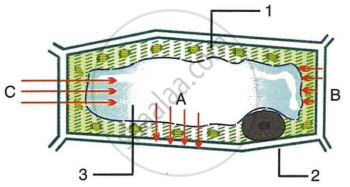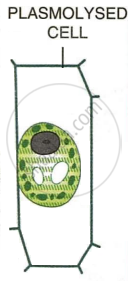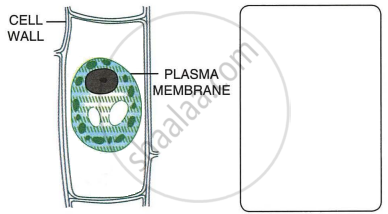Advertisements
Advertisements
प्रश्न
Given below is the figure of a plant cell showing different kinds of pressure acting upon it. Study the figure and answer the questions that follow:

- In the figure, 1, 2 and 3 represent:
- Cytoplasm, Nucleus, Vacuole respectively
- Vacuole, Cytoplasm, Cell wall respectively.
- Cytoplasm, Cell membrane and vacuole respectively.
- Cytoplasm, Cell wall and Vacuole respectively.
- B in the figure represents:
- Osmotic pressure
- Turgor pressure
- Wall pressure
- Diffusion pressure
- A in the figure represents:
- irnbibition pressure
- Wall pressure
- Turgor pressure
- Osmotic pressure
- C in the figure represents:
- Turgor pressure
- Osmotic pressure
- Wall pressure
- Imbibition pressure
- Draw a neat and labelled diagram of a plasmolyzed plant cell.
उत्तर
- iv. Cytoplasm, Cell wall and Vacuole respectively.
- iii. Wall Pressure
- iii. Turgor pressure
- ii. Osmotic pressure

संबंधित प्रश्न
Differentiate between the following:
Turgor pressure and wall pressure
Differentiate between the following:
Turgidity and Flaccidity
What is the difference between ‘flaccid’ and ‘turgid’? Give one example of flaccid condition in plants.
A leaf cell of a water plant was placed in a liquid other than pond water. After sometime, it assumed a shape as shown below:

- Give the term for the state of the cell it has acquired.
- Name the structure which acts as a selectively permeable membrane.
- Comment on the nature (tonicity) of the liquid surrounding the cell.
- Name any one feature of this plant cell which is not present in an animal cell.
- Redraw in the space provided, the diagram of the cell if it is soon placed in ordinary water for some time.
Give suitable biological reasons for the following statement:
Root hairs become flaccid and droop when excess fertilizers are added to the moist soil around them.
Differentiate between the following
Turgor pressure and Root pressure
Name the following:
The process by which wilting or drooping of leaves occurs.
Mention, if the following statement is True or False. If false rewrite the wrong statement in its correct form:
Flaccidity is the reverse of turgidity.
Fill in the Blank
Wilting and drooping of leaves is due to loss of ________.
Give the equivalent term for the following:
Pressure exerted by the cell contents on the cell wall.
